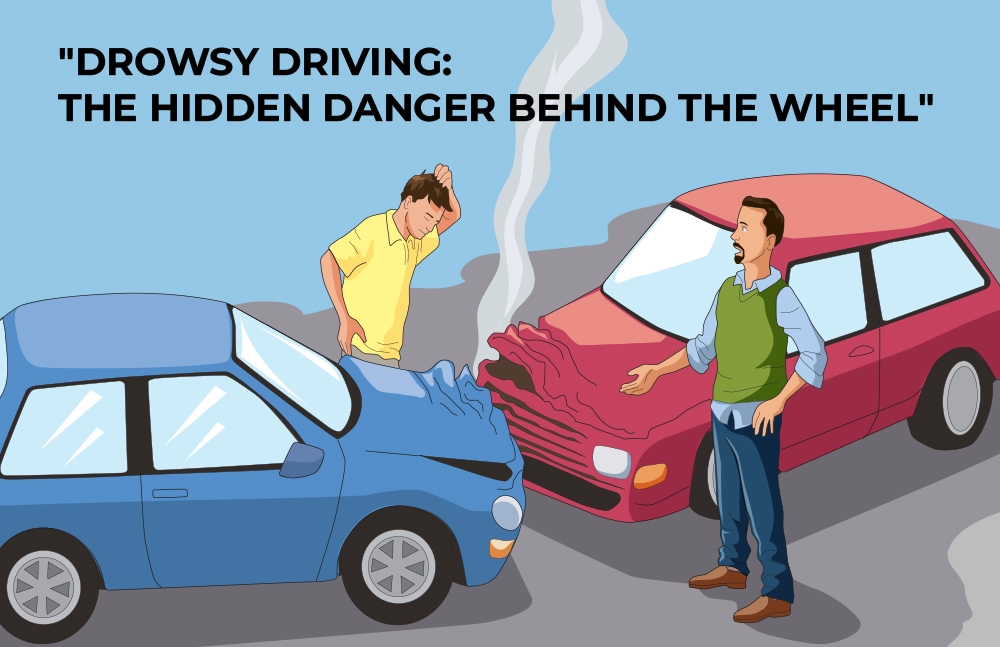
Drowsy Driving and Sleep Apnea: How to Stay Safe on the Road
Introduction: The Hidden Danger of Drowsy Driving
How sleep apnea increases the risk of drowsy driving
As a result, drivers with OSA face a higher risk of drowsy driving and accidents. Studies indicate that severe daytime sleepiness, inadequate sleep (less than five hours), and the use of sedatives further increase the likelihood of crashes.
OSA and Road Accidents in India: The Alarming Reality
Road traffic accidents (RTA) are a major public health concern. Globally, RTAs are the 4th leading cause of death, while in India, they rank 6th, according to the WHO1.
A study by Parameswaran et al2. found a strong link between OSA and increased accident risk among commercial drivers in India. Research conducted on public transport drivers in Trivandrum city revealed that drivers with excessive daytime sleepiness (EDS) had a higher likelihood of accidents, especially when combined with other risk factors such as high BMI, snoring, and Sleep Disordered Breathing (SDB).
While OSA is highly prevalent among commercial vehicle drivers, it is not the only factor contributing to accidents. Reduced reaction time due to sleep deprivation and fatigue further increases the risk of collisions.
Additionally, an Indian Road Transport and Highways Ministry report3 found that:
· 77.5% of RTAs occur due to driver error
· 25% of fatal accidents result from reduced driver alertness
These statistics highlight the urgent need for better sleep health awareness among drivers to prevent drowsy driving accidents.
Preventing Drowsy Driving: Essential Tips for Drivers with Sleep Apnea
Drivers with sleep apnea must take extra precautions to stay alert and ensure road safety. Here are some essential tips to stay alert while driving:
Before Driving
- Get sufficient sleep – Aim for 7–9 hours of quality rest and consistently use prescribed CPAP or MAD therapy.
- Assess alertness levels – If feeling drowsy, taking a nap or delaying the trip is a safer option.
- Plan the journey – Choosing familiar routes and scheduling breaks every 2 hours can help maintain focus.
- Avoid drowsiness-inducing medications – Checking with a doctor about any prescribed or over-the-counter medications that may cause sleepiness is important.
While Driving
- Stay engaged – Keeping the window open, playing music, or interacting with a passenger can help maintain alertness.
- Stay hydrated – Drinking enough water can prevent fatigue and improve concentration.
- Recognize warning signs – Experiencing excessive yawning, blurry vision, or lane drifting signals the need for an immediate break.
- Take regular breaks or rotate driving duties – Stopping for short rest periods or switching drivers when possible helps combat fatigue.
By prioritizing proper sleep, effective treatment, and safe driving practices, drivers with sleep apnea can reduce accident risks and ensure safer travel.
Managing Sleep Apnea on the Road with MAD
For drivers with mild to moderate Obstructive Sleep Apnea (OSA), Mandibular Advancement Devices (MADs) offer an effective and convenient treatment option. These mouthpieces work by gently moving the lower jaw forward, keeping the airway open during sleep. Unlike bulky CPAP machines, MADs are lightweight, portable, and easy to use, making them an ideal solution for drivers on the go.
Benefits of MAD Therapy for Drivers
- Keeps the airway open, reducing breathing interruptions during sleep.
- Manages sleep apnea symptoms.
- Compact and travel-friendly, fitting easily into a small case.
- Requires no electricity, making it perfect for long-haul trips.
- Improves sleep quality, helping reduce daytime drowsiness and fatigue.
By using MAD therapy, drivers can manage sleep apnea effectively and stay more alert, improving both safety and overall well-being on the road.
Conclusion
Sleep apnea is a serious condition that can significantly impact driving safety, especially for long-distance and commercial drivers. Untreated OSA leads to drowsy driving, slower reaction times, and a higher risk of accidents. However, with proper diagnosis, treatment options like CPAP or MAD therapy, and smart driving habits, drivers can manage their condition effectively.
Prioritizing quality sleep, regular breaks, and staying alert on the road is essential for preventing fatigue-related accidents. Addressing sleep apnea not only enhances driver safety but also ensures a healthier and more sustainable driving career.
References
1. Ruikar M. National statistics of road traffic accidents in India. J. orthop. trauma rehabil. 2013;6:1. 10.4103/0975-7341.118718.
2. Parameswaran S, K AC, Prasad JL. Prevalence of sleep disordered breathing and excessive day time sleepiness among heavy vehicle drivers in Trivandrum, South Indian city: A cross sectional study. Int J Adv Res. 2018;6:364–8.
3. Gopalakrishnan S. A public health perspective of road traffic accidents. J Fam Med Prim Care 2012;1(2):144. DOI: 10.4103/2249-4863.104987


